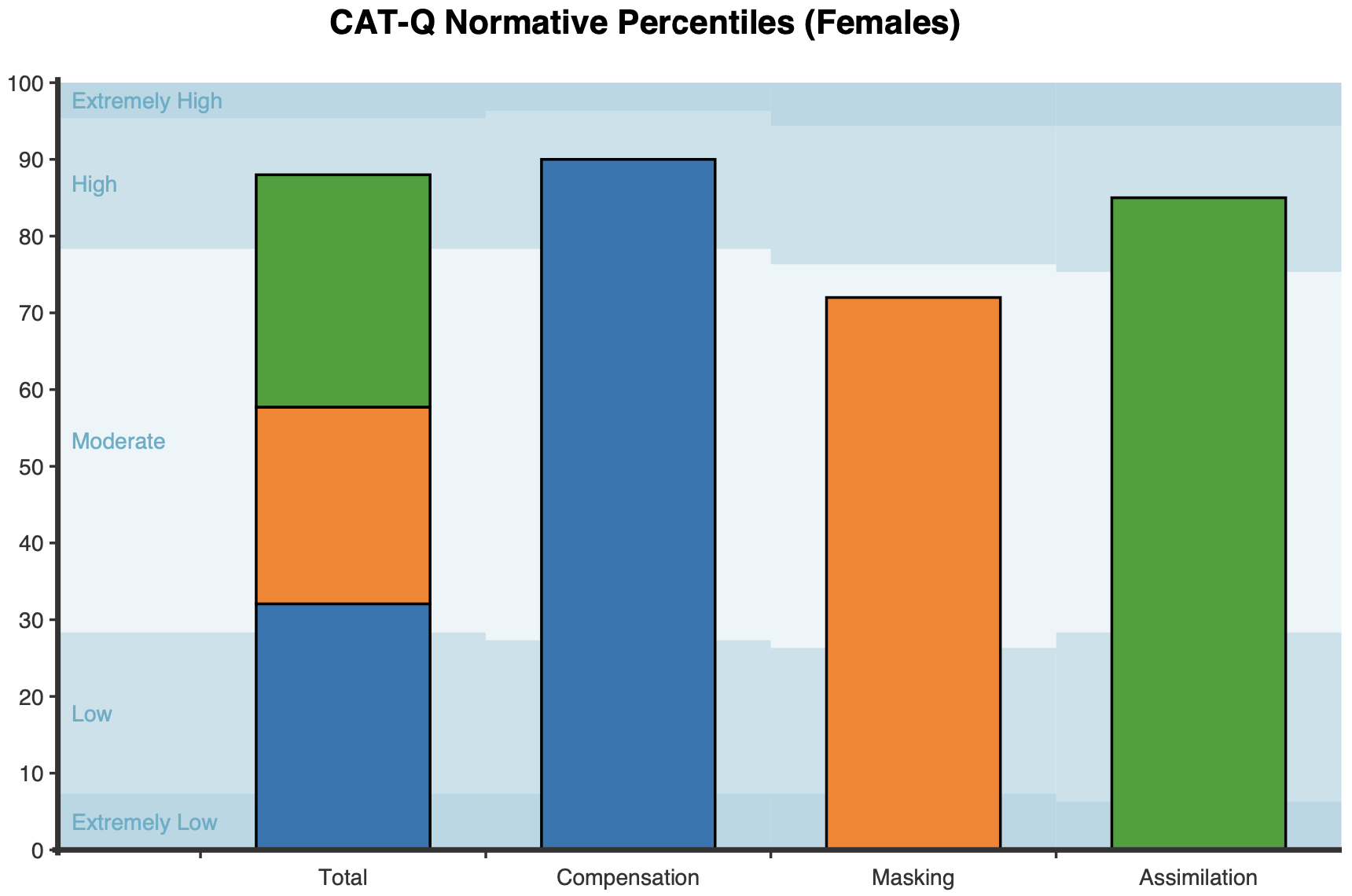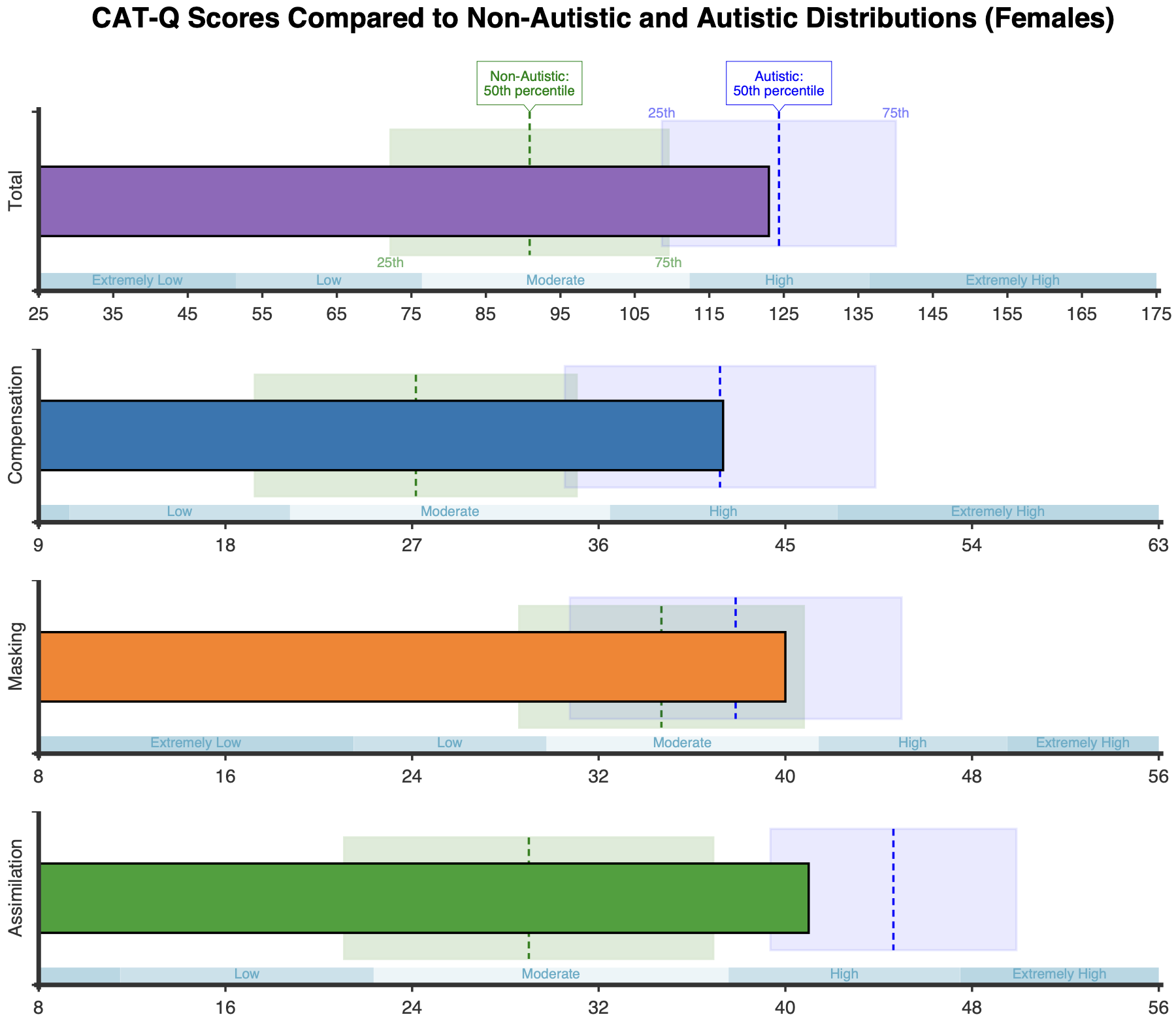The Camouflaging Autistic Traits Questionnaire (CAT-Q) is a 25-item self-report measure designed to assess camouflaging strategies in individuals aged 16 years and older (Hull et al., 2019). The CAT-Q assesses the extent to which camouflaging strategies are used and is particularly relevant for identifying Autism in females and gender diverse people, who may be underdiagnosed or misdiagnosed due to their ability to mask autistic traits.
The Camouflaging Autistic Traits Questionnaire (CAT-Q) is a 25-item self-report measure designed to assess camouflaging strategies in individuals aged 16 years and older (Hull et al., 2019). Camouflaging refers to strategies that people may use to adapt to or mask their autistic traits during social interactions, often to navigate a predominantly neurotypical social environment. The CAT-Q assesses the extent to which camouflaging strategies are used and is particularly relevant for identifying Autism in females and gender diverse people, who may be underdiagnosed or misdiagnosed due to their ability to mask autistic traits.
The CAT-Q provides scores for overall camouflaging as well as three subscales:
The CAT-Q has useful clinical applications in addition to its utility in screening and assessment. Results can be integrated into formulation and treatment, help validate the experiences of Autistic people, and facilitate self-awareness. The nuanced understanding of camouflaging provided by the scale can assist with the identification of treatment targets and guide the development of coping strategies to help reduce negative impacts of camouflaging on well-being, while also recognising its adaptive aspects.
While the CAT-Q provides valuable insights into camouflaging strategies and can be a useful part of a comprehensive assessment for Autism, scores may also reflect phenomena other than, or co-occurring with, Autism (e.g., people with social anxiety may show greater use of camouflaging strategies). It is important to interpret the results within the context of the individual’s developmental history, personal characteristics, and social environment.
The Camouflaging Autistic Traits Questionnaire (CAT-Q) provides scores for overall camouflaging as well as three subscales, with higher scores indicating greater use of camouflaging strategies.
The respondent’s total and subscale scores are expressed as percentiles based on normative data for Non-Autistic adults of the same gender (e.g., male, female, or non-binary) (Baker et al., 2024; Hull et al., 2020). The percentiles contextualise the respondent’s scores relative to the typical scores of Non-Autistic adults. For example, the 50th percentile represents typical levels of camouflaging among Non-Autistic adults, while scores on the 90th percentile fall within the top 10% when compared to Non-Autistic adults.

The scoring approach uses qualitative descriptors to categorise CAT-Q scores (Baker et al., 2024). Each qualitative descriptor corresponds to a specific range of scores. The ranges for these descriptors were determined using percentiles derived from a Non-Autistic sample of 472 male, female, and non-binary adults obtained from a study by Hull and colleagues (2020). The ranges for the total CAT-Q score are as follows.

Graphs comparing the respondent’s total and subscale scores to the normative distribution of scores among Non-Autistic and Autistic individuals are presented, with shaded areas corresponding to scores between the 25th and 75th percentile. This graph contextualises the respondent’s scores relative to typical levels of camouflaging among Non-Autistic and Autistic adults.

If administered more than once, a meaningful change in camouflaging is defined as a change of 13 or more points in the total score based on a Minimally Important Difference (MID) calculation.
It is recommended to interpret CAT-Q scores in light of the following considerations.
The Camouflaging Autistic Traits Questionnaire (CAT-Q) demonstrates robust psychometric properties (Hull et al., 2019). It shows high internal consistency for the total scale (Cronbach’s alpha = 0.94) and subscales: Compensation (0.91), Masking (0.85), and Assimilation (0.92). It also shows good test-retest reliability for the total scale and subscales over a three-month interval (rs = 0.77, 0.78, 0.70, and 0.73, respectively).
The CAT-Q was validated on an age- and gender-diverse sample of 306 Autistic and 472 Non-Autistic adults (mean age = 34.56 years, SD = 14.89 years), allowing for meaningful interpretation of a respondent’s total score and subscale scores relative to both Autistic and Non-Autistic adults of the same gender (Hull et al., 2020). The means and standard deviations for the total score and subscale scores among key groups are as follows:
Autistic:
Non-Autistic:
The above means and standard deviations are used to convert the respondent’s score to percentiles, providing useful information about their use of camouflaging strategies relative to Autistic and Non-Autistic adults of the same gender (Baker et al., 2024). For respondents whose gender is unspecified, percentiles are based on the pooled means and standard deviations for males, females, and non-binary individuals.
While the CAT-Q demonstrates robust psychometric properties, concerns about construct validity remain, particularly regarding its overlap with similar constructs and strategies related to adapting to social norms, social anxiety and other mental health challenges, or neurodivergence more broadly (e.g., ADHD) (Fombonne, 2020; Lai et al., 2020).
Hull, L., Mandy, W., Lai, M. C., Baron-Cohen, S., Allison, C., Smith, P., & Petrides, K. V. (2019). Development and validation of the Camouflaging Autistic Traits Questionnaire (CAT-Q). Journal of Autism and Developmental Disorders, 49(3), 819-833. https://doi.org/10.1007/s10803-018-3792-6
Baker, S., Smyth, C., Bartholomew, E., Buchanan, B., & Hegarty, D. (2024). A Review of the Clinical Utility and Psychometric Characteristics of the Camouflaging Autistic Traits Questionnaire (CAT-Q): Gender-Specific Norms, Percentile Rankings, and Qualitative Descriptors.
Cook, J., Hull, L., Crane, L., & Mandy, W. (2021). Camouflaging in autism: A systematic review. Clinical Psychology Review, 89, 102080. https://doi.org/10.1016/j.cpr.2021.102080
Cook, J., Hull, L., & Mandy, W. (2024). Improving diagnostic procedures in autism for girls and women: A narrative review. Neuropsychiatric Disease and Treatment, 20, 505-514. https://doi.org/10.2147/NDT.S372723
Fombonne E. (2020). Camouflage and autism. Journal of Child Psychology and Psychiatry, and Allied Disciplines, 61(7), 735-738. https://doi.org/10.1111/jcpp.13296
Hull, L., Mandy, W., Lai, M. C., Baron-Cohen, S., Allison, C., Smith, P., & Petrides, K. V. (2019). Development and validation of the Camouflaging Autistic Traits Questionnaire (CAT-Q). Journal of Autism and Developmental Disorders, 49(3), 819-833. https://doi.org/10.1007/s10803-018-3792-6
Hull, L., Lai, M. C., Baron-Cohen, S., Allison, C., Smith, P., Petrides, K. V., & Mandy, W. (2020). Gender differences in self-reported camouflaging in autistic and non-autistic adults. Autism, 24(2), 352-363. https://doi.org/10.1177/1362361319864804
Lai, M. C., Hull, L., Mandy, W., Chakrabarti, B., Nordahl, C. W., Lombardo, M. V., Ameis, S. H., Szatmari, P., Baron-Cohen, S., Happé, F., & Livingston, L. A. (2021). Commentary: ‘Camouflaging’ in autistic people – reflection on Fombonne (2020). Journal of Child Psychology and Psychiatry, and Allied Disciplines, 62(8). https://doi.org/10.1111/jcpp.13344
NovoPsych’s mission is to help mental health services use psychometric science to improve client outcomes.
© 2023 Copyright – NovoPsych – All rights reserved